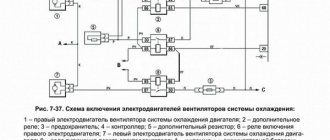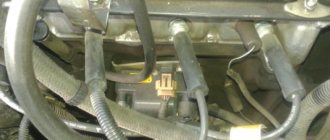In time immemorial, when I was still going to VDNKh to see with my own eyes the next new technology - including the automobile industry, of course - one day a miracle happened. After hanging around the Izh-2126, which could not get into serial production, I looked to the side and saw SOMETHING. After this, the rest of the exhibits ceased to exist for some time.
It looked fantastic. And even now it doesn’t cause the slightest shame.
It looked fantastic. And even now it doesn’t cause the slightest shame.
Where can you go with this?
These are not staged photos or fragments of the accident. It’s just that Niva with Zarulev’s crew showed that it can drive... under water! Details are in the magazine “Behind the Wheel”, No. 10, 2007.
These are not staged photos or fragments of the accident. It’s just that Niva with Zarulev’s crew showed that it can drive... under water! Details are in the magazine “Behind the Wheel”, No. 10, 2007.
View the archive of the magazine “Behind the Wheel”: No. 10, 2007.
We then filmed the experiment itself:
In 1998, Niva climbed under its own power to the base camp on Everest - 5200 meters above sea level. A year later, the machine again visited the Himalayas, where it reached 5,726 meters.
This car with Zarulev’s crew crossed the Sahara! Details are in the magazine “Behind the Wheel”, No. 10, 1989.
This car with Zarulev’s crew crossed the Sahara! Details are in the magazine “Behind the Wheel”, No. 10, 1989.
View the archive of the magazine “Behind the Wheel”: No. 10, 1989.
Niva managed to work for 15 years in Antarctica, at the Bellingshausen station, where in 1990 she was taken at the request of Russian polar explorers. The car's mileage was then 11,800 km.
Niva has been on so many mountains that it’s easy to get confused. This seems to be on Elbrus...
Niva has been on so many mountains that it’s easy to get confused. This seems to be on Elbrus...
Advantages of the Chevrolet Niva over other jeeps
Chevrolet Niva is a unique symbiosis of the Soviet Niva car and high-quality American technology. Its design skillfully combines Russian assertiveness and foreign compactness. Despite the fact that American SUVs do not have average dimensions, the technical characteristics of the Chevrolet Niva fit perfectly into a small body.
For some time, debates continued all over the world about who to take the Niva for - a small jeep or an overly large crossover. The answer is simple - at the time of development and release of this car, the segment called “crossover” did not even exist. It was just beginning to emerge, releasing the first experimental models, which included the Jeep Wrangler, Toyota 4Runner, Jeep Grand Cherokee, BMW X5 and others. Today, the main competitors of the Niva Chevrolet are Hyundai Tucson, Kia Sportage, Kia Sorento and Ssang Yong. They all have approximately the same technical characteristics, but the Chevrolet Niva has a number of advantages, which are contained not only in the engine compartment, but also in the design and interior of the cabin. The advantage of the Chevrolet Niva becomes obvious immediately after the first test in difficult road conditions. Its owners speak highly of it, saying it will stick where many others won't. And this is actually true, because unlike the previously mentioned models, the Chevrolet Niva (or as its owners call it, Shniva) has a high seating position, which allows it to overcome fairly deep ruts and potholes. In addition, a small reservoir with a maximum depth of 0.4-0.6 m is not a hindrance for it. Most competitive cars also have excellent fitment, but their maximum parts lifespan is significantly lower.
The Chevrolet Niva has a solid capacity, which was achieved by increasing the length of the wheelbase, therefore, in addition to five people, this car will be able to transport large cargo in the luggage compartment, the volume of which is 320 liters. For comparison, the volume of the same compartment in the Hyundai Tucson is 295 liters. The difference is small, but sensitive. According to owner reviews, the basic equipment of the Chevrolet Niva is simply excellent. It includes an adjustable steering column, reliable power steering, central locking, heated side mirrors and a good sound system. Of course, other manufacturers also stuff their “brainchildren” with similar bells and whistles, but the Chevrolet Niva is a car proven by time, harsh conditions and a large number of demanding drivers. The technical characteristics of the Chevrolet Niva provide for a long service life of any component of the car. For example, the chassis of the famous Chinese SUV Ssang Yong requires surgical intervention after 70-80 thousand kilometers, while the Niva will begin to show signs of wear on the chassis only after 100-110 thousand kilometers. The advantage of the Chevrolet Niva is obvious - its great popularity speaks for itself. The fact that more than 4 million copies were sold in Russia directly shows that this car has become a people's favorite and is preferred to many other SUV models that do not have the necessary potential or do not suit the owners in terms of configuration.
chevroletniva.com
Movie hero
Niva appeared in a huge number of films, including foreign ones. In Jackie Chan's Who Am I? She actively participates in a rally raid across the African desert. Of the well-known domestic ones, I remember “Gangster Petersburg” (Domogarov’s hero drove such a car). In the final episode of “A Visit to the Minotaur,” an operative is chasing a bad man on the Niva who is escaping in a ZiL cargo truck.
In the film “The Whole World in Your Pocket,” Niva had to make up herself as a non-our collector’s armored car.
In the film “The Whole World in Your Pocket,” Niva had to make up herself as a non-our collector’s armored car.
The world's first crossover: VAZ-2121 "Niva" - About everything and nothing
Well, let's add something from other sources.
How was the car created?
Soviet designers turned to the idea of creating a comfortable domestic SUV in the late 60s. In any case, work began at AvtoVAZ itself in 1970. Since in those days no issues could be resolved decisively without high authorities, it is worth thanking the Chairman of the USSR Council of Ministers, Alexei Kosygin, for the Niva. By the way, he was one of the founders of VAZ itself. In the summer of 1970, Comrade Kosygin visited Togliatti, inspected the conveyor belt and “expressed a wish to see all-wheel drive Zhiguli cars on it.”
As it turned out, the “kopeks” and “treshki” issued at that time (in various modifications) attracted only city dwellers. Villagers, not spoiled by asphalt roads, preferred the “indestructible” “Muscovites”, which were produced in much more modest series. But the organization of large-scale automobile production on the banks of the Volga was conceived, among other things, in order to “pump out” the money supply of savings that were dead weight for the citizens of the USSR - there was nothing to buy anyway... So they decided to organize the production of an affordable off-road passenger car .
And work began to boil. By the way, parallel - and not unsuccessful - design of an SUV has been carried out since 1965 both at Moskvich (where in 1959-61 the all-wheel drive Moskvich-410 was produced in small series and a prototype of the Moskvich-415 SUV was being prepared), and at GAZ , and at the Izhevsk Automobile Plant (then still a very young enterprise). By 1970, two prototypes had already been created there - Izh-5 and Izh-14 (NAMI engineers took part in their development). VAZ workers started work from scratch.
The first version of the car - E2121 - was nicknamed the “crocodile” for its chopped shapes, which were reminiscent of both the Kubelwagen (a floating SUV of the Wehrmacht) and the Willys - it was born 35 years ago, in April 1972. The body lines were straight, the top was canvas, and the front window was folding. Ideas were tested on this mockup. As a result of road tests, several basic principles of the future Niva were determined. For example, permanent differential all-wheel drive, the possibility of using front disc brakes, front independent suspension, the presence of a reduction gear and the need to lock the center differential.
It was only later that leading designer Pyotr Prusov, bodybuilder Lev Murashov and designer Valery Semushkin asked the question - why does the VAZ car not have the “Zhiguli” comfort? And then Semushkin drew a new body... However, they didn’t like the car: the designers pointed out that they were moving away from the classic layout of an SUV - a frame structure, leaf spring suspension, solid axles, and a low-speed, large-volume engine. The VAZ team suggested using a monocoque body - no one in the world had ever made such an SUV before. Suzuki Vitara and Jeep Cherokee appeared later. The fate of the SUV was decided by the then general designer of VAZ, Vladimir Solovyov - it was he who convinced the plant’s technical council to once again consider the developers’ proposal. And after very heated debates, the project was approved.
And soon the time came for the first tests - accompanied by military UAZs, camouflaged prototypes (their radiator grille was decorated with a Latin F - Semushkin explained to everyone curious that this was a new Fiat model) passed under their own power through the deserts of Central Asia to the southernmost point of the USSR - the city of Termez. The mileage showed that it is necessary to finish the front suspension, cooling systems, ventilation and air intake. In addition, it was decided to abandon solid glass doors - they were warped. However, the most serious changes had to be made to the suspension. The plant did not have equipment that would allow the production of synchronous universal joints. I had to buy a license for CV joints from.
And on February 16, 1974, tests began at the Dmitrov test site, in which the VAZ-2121 and Izh-15, which had already received the index, took part. Their performance was compared with the test UAZ-469, Land Rover and Range Rover. No matter how proud people in Izhevsk were of their all-terrain vehicle, tests showed that the vehicle was very “crude.” The Niva was faster (130 km/h versus 120 for the Izh-15), acceleration to hundreds took 22.1 seconds (versus 30.5). The VAZ model handled better. Without a doubt, the Izh could have been improved! And, probably, it is necessary. But at that time, the automotive industry was developing thanks to injections from the state budget, and the Council of Ministers decided that the auto industry could not handle two SUVs.
A year later, Niva was shown to the general public. At that time, there were no car shows yet, and the premiere took place in August 1975 at VDNKh.
And finally, it happened: on April 5, 1977, the first production car, the VAZ-2121, rolled off the VAZ assembly line. Those cars had a lot of serial parts from “three-ruble” cars - for example, lights, which were later replaced with more modern “six” ones. And the headlights remained “three-point” for a long time.
www.club-suv.ru
History of the creation of "Niva"
The compact SUV VAZ-2121 “Niva” with a monocoque body is rightfully considered the most original and successful development of the domestic automotive industry. In the late 70s, the Niva created a real sensation on the world market with its unique combination of passenger comfort and high cross-country ability at a more than competitive price (though only outside the USSR). The cross-country ability, enviable even for many modern analogues, was achieved thanks to permanent all-wheel drive, a locked center differential and a range-of-multiplier in the transmission, as well as successful weight distribution along the axles. In this case, the power unit was taken from the mass model Zhiguli VAZ-2106, and the transfer case was connected to the gearbox by an intermediate driveshaft. For countries with preferential taxation of small cars, a version of the VAZ-21211 with a 1.3-liter “21011” engine was produced.
Many foreign tuning companies offered successful plastic body kits and other types of fine-tuning for the Niva, for example, not at all superfluous, additional sound insulation. Some even made pickup trucks based on it. By the way, since the 90s, the Niva has been one of the favorite objects for Russian tuning workshops. According to the design of the VAZ-2121
was maximally unified with
the Zhiguli (in terms of the power unit and many interior elements - with the VAZ-2106 ), but this turned out to be not entirely justified, especially in relation to a separate transfer case connected to the standard Zhiguli gearbox with a short driveshaft.
In the absence of mutual balance between these units, the transmission is terribly noisy. This knot became the “Achilles heel” of the model. In the 90s, with the end of the shortage of a number of spare parts, the Niva became the most affordable domestic SUV. The plant now has the opportunity to create various modifications that are in demand on the market based on the Niva , as well as to modernize the base model.
So, in 1993, a transitional version of the VAZ-21219 appeared with an old body and a more powerful and high-torque 1.7-liter carburetor engine “21213” equipped with a contactless ignition system. The gearbox was equipped with an overdrive 5th gear (although not all cars had it installed), the gear ratios of the main pairs were changed from 4.3 to 4.1 and 3.9, which reduced fuel consumption. In addition, a shaft with a CV joint from the Oka , which somewhat reduced noise and vibration. In 1994, the Niva VAZ -21213 received a modernized body with a third door extending to the bumper and square lights instead of the rectangular ones from the “six”. The updated interior features a modern instrument panel of the “2108” type, as well as redesigned front seats. Another intermediate version with an old 1.6-liter engine was designated VAZ-21217 , and the export version with a Peugeot diesel engine was designated 21215. Even such a half-hearted modernization allowed the Niva to successfully survive into the 21st century. the Niva has difficulty meeting modern requirements for passive safety By the way, getting in and out of the fully foldable rear seat is very difficult, and the trunk is frankly too small for a multi-purpose vehicle.
In the 90s, version 21214-36 with an engine equipped with a central injection catalytic converter. Then the engine was modernized for distributed injection and began to be supplied to the domestic market (without a converter).
The Niva is not designed for constant off-road driving, and at the same time it is not very convenient for city use due to increased fuel consumption, “heavy” steering wheel (without power steering) and a noisy transmission. However, its competitive price, relative cheapness of spare parts and ease of repair attract attention even to used Niva copies.
At one time, the fate of the Niva was in question due to the organization of the GM-AVTOVAZ joint venture to produce the Chevrolet Niva . According to the agreement with the Americans, production of the old model was supposed to cease by 2006, but due to the revision of the agreement, Avtovaz now has the opportunity to produce the Lada Niva (as the Niva has been officially called since 2005). In addition, since 2003, its CKD kits have been supplied to a new assembly plant in Ust-Kamenogorsk (Kazakhstan), to the Ukrainian LuAZ and several assembly plants in South America.
VAZ-2121-21214 ( Lada Niva ) is one of the most popular SUVs on the domestic market; even new cars have practically no competitors in terms of price + quality + cross-country ability, and moderately used ones (from a year to three) are generally beyond competition. All the specific problems of this model are well known to repairmen (although they are not always successfully treated), spare parts are quite cheap and are no less common than for Zhiguli . When purchasing, you must carefully inspect the body and chassis for intensive use. If the car was often used off-road or as a tractor, it is better to refuse such a purchase. All other things being equal, it is better to choose a car with a less noisy transfer case.
October 27, 2011 at 11:43 am











